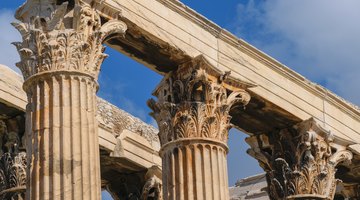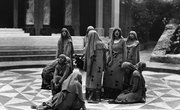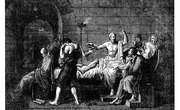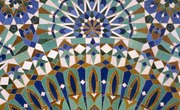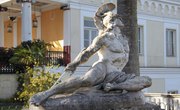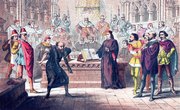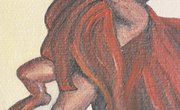The period given over to "classical" Greek sculpture includes three distinct styles spanning hundreds of years, starting in approximately 600 B.C. These styles, starting with the earliest, are the archaic, the classical and the Hellenistic. It's easy to see the progression of Greek art by observing these styles chronologically. The archaic style is stiff and rigid. The classical style is more realistic and includes the representation of movement. The Hellenistic style gives over to the results of centuries of the Greek study of the human form.
Archaic
This period was between 600 and 480 B.C. Many of the archaic sculptures are compared to the style of the Egyptians, due to the stiff poses that lacked movement. The statues were often used to line the entrance ways to temples or for marking graves. The statues are either male or female and are robed in a standing position. The male statues are called kouroi ("young men") and the female statues are called kourai. The males are depicted as athletes, warriors and gods. The women represent goddesses, nymphs and priestesses. One way to recognize an archaic piece is to look at the mouth. All statues have the same apparent grin. One of the famous archaic sculptures is called "The Calf Bearer" and exhibits the tell-tale signs of the archaic period.
Classical
This period is from 500 B.C. to 323 B.C. During the classical period Greece reached its height of success, economically and culturally. The human form began being depicted in stances of movement, particularly in athletic movement; it was also the beginning of the Greek physical ideal. Bodies took on a natural, more realistic form. The male form was represented as a fit, healthy and young man whose muscles and shape were carved out of the marble. Women were often nude on top and robed on the bottom or completely nude. They had soft round abdomens, full hips and legs and small breasts. One of the key characteristics of this period is the controposto stance, or s-curve. One leg is forward, in front of the other bearing the weight of the body. Look at the discus thrower for an example of movement and Doryphoros for the classic controposto pose.
Hellenistic
This period spanned from the mid third century to the first century B.C. The Hellenistic period was varied and delved more into reality and artistic flourish. After centuries of carving out the human form, the Hellenistic sculptors were at the height of their abilities. The use of shadowing, the incredibly real depiction of fabric draping, facial expression, age and emotion are all in evidence. While certain details were sparse in earlier periods, every sinew was etched out of marble or bronze. The Laocoon is an ideal example of this period. Laocoon is a figure in Greek mythology who warned the Trojans of the Trojan horse. For it, he suffered death by serpent. In the sculpture he is flanked by two men, one on each side, and about to be entangled by the serpent. The detail of his body and face are astonishing.

